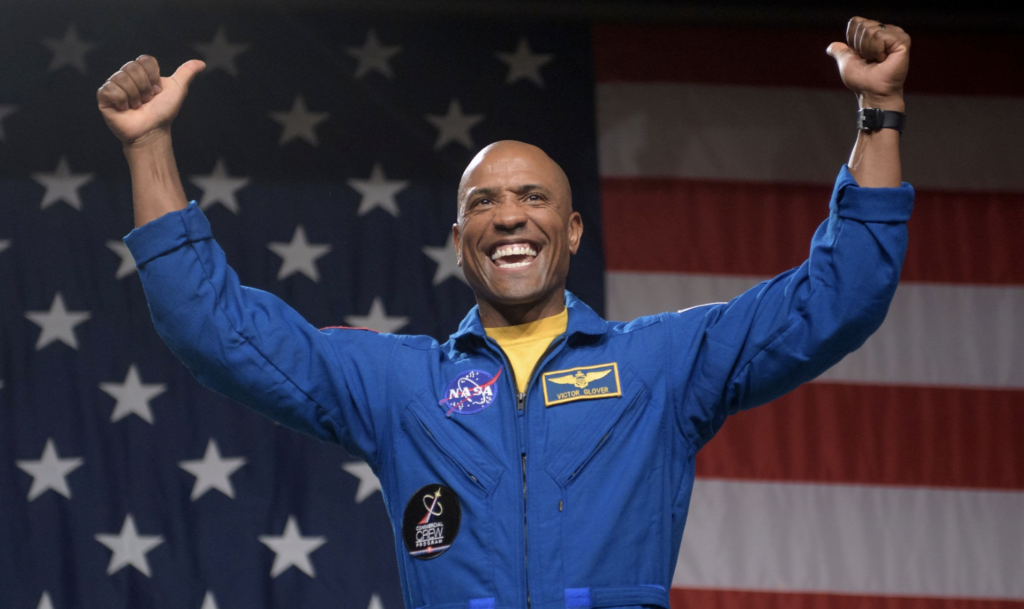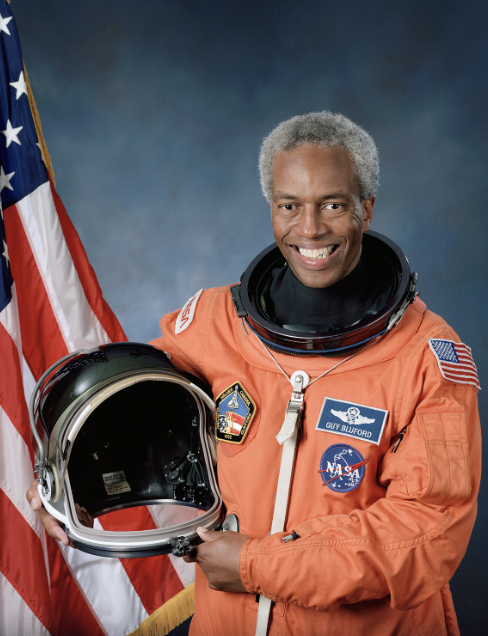

I recently came across the New York Times article, “NASA Is Recruiting a New Class of Astronauts,” when researching potential candidates who could be the next featured profiles for Wesleyan University’s College of Sciences’ Inclusion in STEM Initiative. I don’t know about you, but I have always been intrigued by NASA’s space program and the concept of humanity going to space. This was the first aspect of the article that caught my attention; how could I stop reading? It was about NASA. As I kept reading, I realized this article would be a great fit for the Inclusion in STEM Initiative on four fronts. The first criterion that the article checks off is that it is related to STEM. The second is that it centers around Victor Glover, a nine-year veteran of the astronaut corps who will be the first African American astronaut to travel around the moon. The third is that the article also highlights the growing distance between NASA and the private sector due to NASA’s awareness and intention on diversity through their hiring process. The fourth and final criterion the article meets is providing a social commentary on the hierarchical structures and collective implicit biases in society. My article aims to continue where New York Times’ reporters, Kenneth Chang, and Emma Goldberg, end their narrative. I argue that while Chang and Goldberg’s article draws out crucial and remarkable points about the victories and progress of diversity, they have failed to discuss the factors of why society has only just selected its first African American astronaut to orbit the moon.
Chang and Goldberg’s article effortlessly acquaints the reader with NASA’s hiring process, requirements, and their selected astronaut, Victor Glover, for its Artemis II mission, orbiting the moon without landing. In the first few months of 2024, NASA released a job listing looking for its next group of astronauts. Chang and Goldberg had the pleasure of interviewing April Jordan, NASA’s astronaut selection manager, who relayed that the position is ‘very popular with slim to no odds that you will be chosen.’ Based on statistics of NASA’s hiring process for previous positions, NASA’s highly selective positions attract over 12,000 applicants, while only selecting 10 individuals. Chang and Goldberg, gratefully, do the calculations for us and reveal that NASA selects only 0.083 percent of their applicants, confirming Jordan’s description of ‘slim to no odds.’
Despite these odds, Jordan is characterized as the astronaut selection manager who is determined to challenge the traditional archetypes of astronauts, established in the 1960s. Back in the day, astronauts were nearly all white men who had military backgrounds. In Chang and Goldberg’s interview, Jordan is joined by Victor Glover, NASA’s selected astronaut, to further aid the perception and understanding of NASA’s hiring process and requirements. Glover states that today’s astronauts need to be U.S. citizens, pass the astronaut physical exam, and have a master’s degree in science, technology, engineering, or mathematics, accompanied by at least three years of related professional experience. Luckily, he possesses all the necessary qualifications. Glover was a Navy aviator who became the first African American astronaut stationed on the International Space Station. Having been chosen for NASA’s Artemis II mission, Glover will be the first African American person to orbit the moon without landing. Glover believes that attaining diversity is not about ‘lowering standards and accepting less qualified candidates,’ but rather about excellence. He states, ‘As long as you don’t equate whiteness or maleness with excellence, then we’re good.’ Chang and Goldberg describe Glover’s sentiment as the two, diversity and excellence, are not mutually exclusive.
‘We want the group of astronaut candidates that we select to be reflective of the nation that they’re representing.’
– April Jordan,
NASA’s astronaut selection manager
One of Jordan’s most memorable quotes she offered Chang and Goldberg is: ‘We want the group of astronaut candidates that we select to be reflective of the nation that they’re representing.’ Despite conservative ideals or desires, the United States’ population is becoming a majority of “marginalized individuals.” I interpret Jordan’s sentiment to be, that if the nation is becoming more diverse, government agencies and space initiatives should grow more diverse as well. NASA aims to be an accurate microcosm of society, reflecting the diverse population. Glover is one of the few African American individuals selected by NASA, a testament to the gradual progress and efforts to make NASA’s aim a reality. Glover emphasizes that currently, NASA is surpassing its aim and has a higher percentage of African American astronauts than African Americans in the broader STEM industry. He victoriously, relays that ‘[NASA’s] office looks the way it looks because of this intentionality and thinking about our biases and how it may affect who we hire.’ While every victory, no matter how small, should be celebrated, Glover conveys sadness when responding to the question of how he feels about being the first African American astronaut to go on a lunar mission.
It is almost 2025, why has it taken this long to select an African American astronaut to orbit the moon?
This question is where Chang and Goldberg stopped, but where I will continue by illustrating obstacles at NASA that have prevented qualified astronauts of color and female astronauts from being selected for highly selective, high-profile missions. The first African American astronaut in NASA history is Guion “Guy” Bluford. He was the first African American in space and was aboard the Space Shuttle Challenger mission – launching into low Earth orbit – in 1983. In an interview, Bluford was asked, “What were some of the challenges you faced being the first African American man to fly in space?” Bluford relayed that when he came into the space program, there were six women, one of whom was Asian American, and only two other African American men. He says that they recognized that they were breaking historical barriers and that one of them was bound to get selected for the high-profile missions, eventually. However, it was a waiting game and none of them anticipated being the first. If there were a total of eight astronauts that were not the traditional white male astronaut archetype but none of them thought that they would be selected, then this illustrates the implicit biases and favoritism towards white men at NASA.
Why did they believe that none of them would get chosen? The obvious answer is the obstacle of racism. They most likely doubted that they would get selected based on the implicit bias that they were inferior to the white male astronauts. This is what Glover was talking about when he said people should only be selected by NASA based on excellence and past professional experience, not race or gender.
‘As long as you don’t equate whiteness or maleness with excellence, then we’re good.’
– Victor Glover,
the first African American astronaut to travel around the moon in 2025
More recently, in 2013, there was a lawsuit that was filed by African and Asian American employees at NASA accusing the agency of racial discrimination. They claimed that NASA’s Employee Performance Communication system, a performance management system that was implemented annually, consistently showed that employees of color were systematically performing worse than white employees. No wonder only white men were being selected for high-profile missions. The system, itself, was equating excellence with whiteness, as well. The system was providing evidence that reflected the implicit biases, already established in NASA’s work environment, towards people of color. The lack of awareness of such racial and gendered implicit biases has not only influenced NASA’s selection process but also their annual employee performance evaluations. The sad fact of the matter is that NASA equates excellence with male whiteness, and white men continue to be chosen.
Glover is a historical, astronautical, groundbreaking figure not because implicit biases cease to exist and NASA has overcome them, but rather because of NASA’s growing efforts to be aware of them. One attempt to combat this racial and gendered inequality is NASA’s efforts to establish its Diversity, Equity, and Inclusion (DEI) programs and initiatives. Racial and gendered biases are inherent to society, but Glover is a testament to how becoming aware of such biases can influence social systems, such as NASA’s hiring selection process.
Sources: Barnes, De’Aundre. “Astronaut Guion "Guy" Bluford on What It Meant To Be the First Black Man to Fly in Space.” Oprah Daily, 21 Apr 2024. https://www.oprahdaily.com/life/a36634334/guion-guy-bluford-interview/ Chang, Kenneth, and Emma Goldberg. “NASA Is Recruiting a New Class of Astronauts.” The New York Times. The New York Times, 22 Mar 2024. https://www.nytimes.com/2024/03/22/science/nasa-astronauts-victor-glover-elon-musk.html?smid=url-share/ NASA. “NASA Astronaut Victor J. Glover.” NASA, 21 Apr 2024. http://www.nasa.gov/humans-in-space/astronauts/victor-j-glover/ Smithsonian. “1983: First African American in Space.” National Air and Space Museum. Smithsonian, 30 Aug 2016. https://airandspace.si.edu/stories/editorial/1983-first-african-american-space#:~:text=Guion%20Bluford%20made%20history%20on,of%20Guion%20%E2%80%9CGuy%E2%80%9D%20Bluford/ Uri, John. “Honoring Black Astronauts During Black History Month 2023.” NASA. NASA, 23 Feb 2023. https://www.nasa.gov/history/honoring-black-astronauts-during-black-history-month-2023/ Wagner, Erich. “A 9-Year-Old Case Alleging Discrimination by NASA Can Finally Proceed.” Government Executive, 5 Oct 2022. https://www.govexec.com/workforce/2022/10/nine-year-old-case-alleging-discrimination-nasa-can-finally-proceed/378078/


